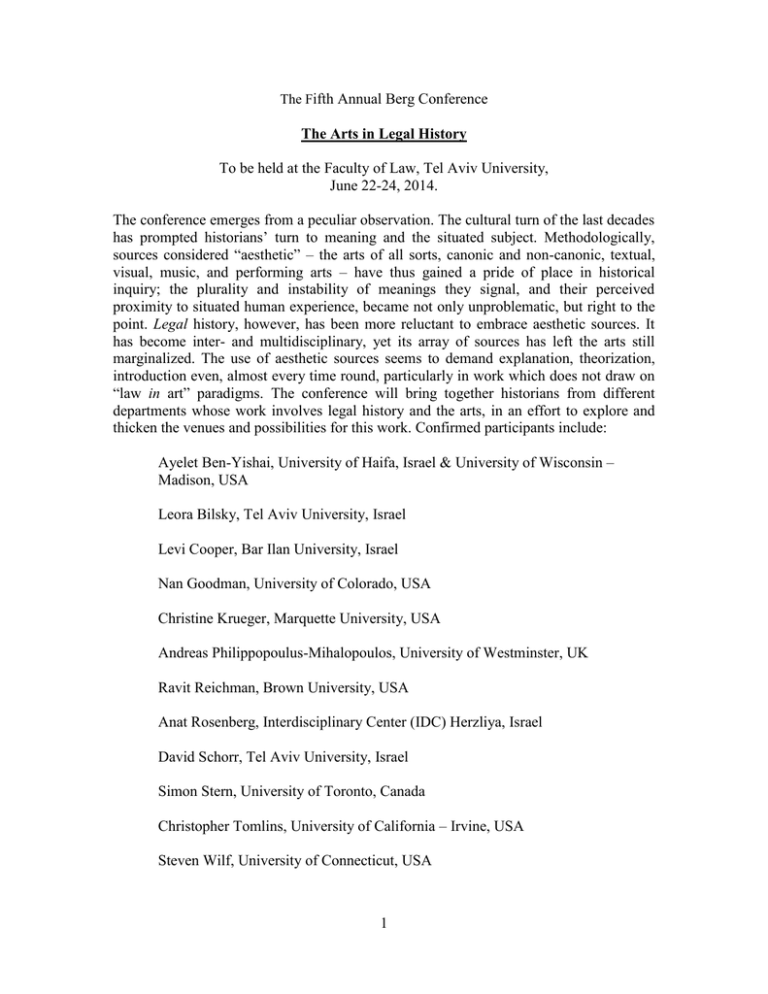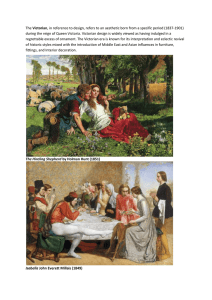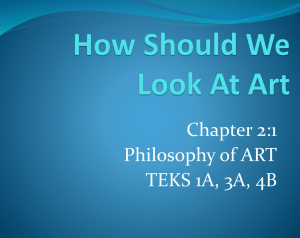The Victorian Art of Legal History
advertisement

The Fifth Annual Berg Conference The Arts in Legal History To be held at the Faculty of Law, Tel Aviv University, June 22-24, 2014. The conference emerges from a peculiar observation. The cultural turn of the last decades has prompted historians’ turn to meaning and the situated subject. Methodologically, sources considered “aesthetic” – the arts of all sorts, canonic and non-canonic, textual, visual, music, and performing arts – have thus gained a pride of place in historical inquiry; the plurality and instability of meanings they signal, and their perceived proximity to situated human experience, became not only unproblematic, but right to the point. Legal history, however, has been more reluctant to embrace aesthetic sources. It has become inter- and multidisciplinary, yet its array of sources has left the arts still marginalized. The use of aesthetic sources seems to demand explanation, theorization, introduction even, almost every time round, particularly in work which does not draw on “law in art” paradigms. The conference will bring together historians from different departments whose work involves legal history and the arts, in an effort to explore and thicken the venues and possibilities for this work. Confirmed participants include: Ayelet Ben-Yishai, University of Haifa, Israel & University of Wisconsin – Madison, USA Leora Bilsky, Tel Aviv University, Israel Levi Cooper, Bar Ilan University, Israel Nan Goodman, University of Colorado, USA Christine Krueger, Marquette University, USA Andreas Philippopoulus-Mihalopoulos, University of Westminster, UK Ravit Reichman, Brown University, USA Anat Rosenberg, Interdisciplinary Center (IDC) Herzliya, Israel David Schorr, Tel Aviv University, Israel Simon Stern, University of Toronto, Canada Christopher Tomlins, University of California – Irvine, USA Steven Wilf, University of Connecticut, USA 1 Abstracts David Schorr (Tel Aviv University, Israel) Environmental Law in the Arts The environment is one of the most physical of subject matters that is regulated by law. Aesthetic sources, particularly the visual arts, might thus seem to be a fertile field for the study of the history of environmental regulation, and historians have indeed used art, such as Monet's paintings and Dickens's novels, to learn about environmental conditions in Victorian London and elsewhere. Yet when going beyond the physical to explore the normative, what can study of aesthetic sources teach us about legal-environmental history that traditional legal sources cannot? First, artistic depictions of the environment can illuminate attitudes to environmental issues that led to legal developments. Indeed, the canon of events that are typically cited as leading to the outburst of American environmental legislation that began in 1970, were all themselves (e.g. Rachel Carson's Silent Spring) or mediated through sources (e.g. photographs of the burning Cuyahoga River) that, while not necessarily "high" art, were all "aesthetic". Moreover, a methodological challenge presented to historians studying the physical aspects of environmental history—the subjectivity of the sources—may turn out to be an advantage when studying the background to environmental law, as subjective attitudes to environmental issues are arguably at least as important as the objective environmental reality. Second, by depicting environmental conditions in the wake of legal developments (e.g. Monet's paintings of the Thames), art can teach us about the historical effects of environmental law. Finally, as to the law itself, in some cases (as in Joseph Roth's Hotel Savoy), art may even help to uncover a form of environmental regulation (here regulation of industrial pollution by the police) that is absent in traditional legal and historical works. Andreas Philippopoulos-Mihalopoulos (University of Westminster, UK) Surface: Lines of Fraternisation The incidents of fraternisation across the barracks during WWI have been generally concealed or even denied. Yet recent research shows that such exchanges took place regularly, especially in the beginning of the war and between the English or Scottish on the one side, and the Germans on the other. The 2005 film Joyeux Noel by Christian Caron that deals with the subject encountered the express refusal of the French authorities to support the cause and help with the filming. Behind the persistent denial of the event of fraternisation there lies a fear of the continuum that defies boundaries and lines of waiting and allows instead to reveal what I have called surface, namely the flat ontological continuum on which various legal foldings take place. Surface is assembled by spatial, temporal, symbolic and material elements, and it is on this surface that the conflicts of spatial justice emerge. The event of fraternisation as shown in the film as well through current historical research operates as the surface on which issues of spatial 2 justice, namely spatial and corporeal claims, are being rehearsed, and solved in rather unorthodox yet instructive ways. Levi Cooper (Bar Ilan University, Israel) The Cantor, the Mystic, and the Jurist The great Cantor Yossele Rosenblatt (1882-1933) was offered an opportunity that would make any performer swoon. Without any formal Hollywood audition, Rosenblatt was offered a star role in the first ever talkie: The Jazz Singer (1927). Rosenblatt, bedecked in his Eastern European hasidic attire, with his bushy beard and small but regal stature, was the perfect choice to play the father of hero Jakie Rabinowitz – a boy who leaves his Jewish heritage for the Broadway stage. Yet Rosenblatt refused this artistic opportunity of the lifetime. This paper is an attempt to contextualise Rosenblatt’s baffling decision, by exploring one particular aspect of the relationship between Jewish law and the art of hasidic storytelling. Storytelling is an aurally aesthetic art form. In nineteenth century hasidic tradition, storytelling was considered a religious activity laden with mystical significance. It also served as a prime medium for the inculcation of hasidic values. In the twentieth century, largely thanks to the work of Martin Buber (1878-1965), hasidic tales transcended their Eastern Europe origins. In contemporary society, hasidic tales continue to animate and to inspire. The relationship between storytelling and law is not cut of one cloth, even within the hasidic tradition and certainly when considering other societies. This paper will consider the two modes – law and storytelling – where they act as parallel paths to a common goal in hasidic society. I will focus on the issue of performance of prayers outside of the religious service. A prime example – and apparently rife occurrence – was the question of the propriety of cantorial concerts that presented prayers from the Day of Atonement liturgy. I will present legal writing and hasidic storytelling that grapple with this phenomenon – each modality using its own tools to tackle the trend. This exploration will bring us back to Cantor Yossele Rosenblatt’s bewildering decision not to become a Hollywood star. I will conclude by considering the broader implications of this type of interplay, suggesting that in a legal system without an effective mechanism for enforcement – as was the case for Jewish law in the nineteenth century – art forms could be a salve. Moreover, societies where arts reign supreme may be able to solve disputes while avoiding certain costs that law imposes. 3 Nan Goodman (University of Colorado, USA) “I hear no things laid to my charge”: Listening to the Law and the Auditory Aesthetic in Anne Hutchinson’s Trial Transcript Of the five senses on which our aesthetic appreciation of the world relies, vision has long played the dominant role, while hearing has typically come in a distant second. What we see, or so the story goes, is more influential and more reliable than what we hear in the sense that it can, with crucial exceptions, be seen again and again. Sound is said to be more fleeting and ephemeral. In recent years, however, more attention has been paid to the role of hearing—both to what we hear and how we hear it--with a great deal of work devoted to soundscapes and sound ways as cultural forms with material implications for how we understand the world. In particular, sound scholars such as Emily Thompson, Veit Erlmann, Jonathan Sterne, Richard Cullen Rath, and Mark M. Smith, have attempted to capture the sounds of the digital and cinematic technologies of the twentieth and twenty-first centuries, the industrial sounds of nineteenth-century America, and even the unrecorded sounds of the seventeenth and eighteenth centuries, recovering entire worlds that would otherwise have been lost to us. The law, however, has remained largely unaffected by these recovery efforts. Traditionally seen as detached from the realm of art and aesthetics entirely, the law has only recently come into its own as a visual medium, beholden despite the figurative blindness of its central icon—justice--to the images at the heart of its rituals and ceremonies. We have, of course, long been attentive to the way in which the law resounds metaphorically in our culture and to the way in which courtroom procedures are often punctuated by sounds such as the gavel on the bench or the shout of “all rise” when a judge enters. Yet we have not fully taken account of how the law sounded in the past, in terms not only of its sonic cues, but also of its phenomenology—in short, how its very ability to distinguish truth from falsehood and to mete out justice was bound up with its aurality. Using Anne Hutchinson’s trial testimony before the General Court of the Massachusetts Bay Colony in 1637, this paper makes two points. The first is that the law, especially as it was understood in seventeenth-century America, was primarily an auditory phenomenon whose role in the hierarchies of knowledge production at the time cannot be understood without attending to its audibility. The second point is that when we recover the law through the aesthetic of sound, we open up new ways of understanding what Hutchinson and her main interlocutor, Governor John Winthrop, were arguing about and what the trial meant in the context of the larger antinomian crisis as a whole. More specifically, the paper argues that when we understand Hutchinson’s trial testimony in terms of its emphasis on an auditory aesthetic, we see her claim to have had a revelation at the end of the trial—a claim that was anathema to the Puritans and that ultimately compelled the court to banish her—in an entirely new light. The claim to have had a direct communication from God, in other words, a religious claim that has in the scholarship on this otherwise secular trial been oddly placed at its center, was no more than the religious counterpart to Hutchinson’s view of the common law. Insisting throughout the trial that she “hear” the law, an insistence that as the quote embedded in 4 the title of this paper suggests required more than the mere recitation of the law, Hutchinson, I argue, understood the revelation at the end of the trial as being on a secular to sacred continuum, inviting us, her modern day readers, to recover the centrality of hearing and sound to the common law as she and other early moderns understood it. Ayelet Ben-Yishai (Haifa University, Israel & University of Wisconsin- Madison, USA) The Presumption of Legal Culture My paper argues for law and literature scholarship that challenges a monolithic understanding of law and of culture. Building on scholarship which foregrounds legal plurality, I base my approach on an understanding of legal culture in which the law is not considered simply as a set of rules and decisions but a living, dynamic construct containing disparate entities in varying degrees of tension with each other. This legal culture is not only plural and constantly changing, but also capacious, encompassing much that is outside the narrower confines of what we tend to call “the law.” In this paper, I turn to nineteenth-century realist fiction, which often presents a keen awareness of Victorian changing legal plurality. This awareness, I contend, undergirds realism’s obsession with the law, akin as it is to the plural and dynamic nature of Englishness itself. In my reading, literature neither reflects legal culture nor stands in contrast to it. Rather, it participates in what Patricia Ewick has called the “mediating process through which social interactions and local processes aggregate and condense into institutions and powerful structures” (38). Both law and literature thus function as strategies of representation, ways of understanding and regulating the complexities of social and personal relations and structures. Paying attention to the forms with which realist fiction engages with the law affords a fascinating insight into the way the institutions and structures of legal culture are constructed and maintained. My paper brings this approach to bear on the common formal foundation of the Victorian realist novel and of legal presumptions – the legal rule which assumes a fact is true unless there is a greater weight of evidence which disproves it – in Victorian common-law. Focusing on the presumption of legitimacy, which states that a child born within the subsistence of a marriage is deemed to be the child of the husband, I examine the way that this presumption, like other legal presumptions and like realist fiction, marks the normal mode of things, the way things could be and most probably are. For example, by showing how different characters at different points in Anthony Trollope’s Is He Popenjoy? adhere (or not) to this legal presumption, the novel reveals the inherent instability of “taking things for granted.” And yet, the social order depends on these legal conventions, if only to mark a deviation that reinforces its norm, just as the realist novel depends on conjecture and probability to establish the truthfulness of its fiction. Despite its conventional, rather than empirical, truth-status, presumption, I will argue, comes to anchor the foundations of stability in the legal and textual culture of the novel. This analysis thus shows how law and literature engage together in the period’s epistemological questions and how literary realism participates in a legal culture, challenging more monolithic conceptions of the law. Regarding “the law” as constant 5 rather than dynamic, or as uniform rather than multiple is not only to misunderstand the law, but also to miss out on much of what the interdiscipline of law and literature has to offer. By ending with the implications of legal culture for reading literary form, I hope to make clear that in so doing, this kind of scholarship has the potential not only to promote a more capacious understanding of the law, but also to challenge our own assumptions about literary form, about realism, about culture and about the way we make meaning in the world. Leora Bilsky (Tel Aviv University, Israel) International Law as the Modern Oedipus: the Emergence of a Right to Truth This paper offers a critical history of the emergence of a “right to truth” in international law by reading this development in light of Sophocles’ King Oedipus. Formulated as both a right of individual victims and a collective need of societies with a past of state-sponsored violence, the right to know the truth about human rights violations has emerged in the past three decades in various sites of international law. This process is connected to the changing status of the individual victim and can be understood as a response to authoritarian regimes which tended to hide their actions, deny the crime altogether, reduce its dimensions, or justify it by the need for security or other pressing social need. The increased legalization of the truth is therefore viewed by scholars as a positive development that signals increased recognition of human rights norms. Contrary to the triumphant tone of contemporary human rights scholarship, I suggest viewing international law as a modern Oedipus - as a field that began its quest to find the truth as part of a more general commitment to the goal of ending the era of immunity and prosecuting those responsible for horrendous crimes, but finished with an absolute right to the truth that became an independent objective. The tragedy of Oedipus is one of the rare sites in which the interaction of truth and law is critically evaluated, and I argue that a close reading of the story exposes the structural dangers in the truth – and in particular family-related truths - becoming the overriding objective of legal investigation. I begin with a close reading of King Oedipus focusing on the search for the truth and its transformations. I then move to Argentina to examine the legal struggle of the Grandmothers of the Disappeared to find the truth about the disappeared, and to bring an end to impunity for complicity in the “dirty war.” I end by asking what new insights the comparison can bring to our understanding of the history and development of the right to truth in international law. Ravit Reichman (Brown University, USA) Precious and Profane: Toward a Wider Account of Material Claims This paper looks at two tendencies of property in the wake of the Holocaust, the historical and narrative trajectories of which have had little to say to each other thus far. The first, an instance of contested property, consists of efforts to find stolen works of art 6 and reunite them with their rightful heirs. The second concerns personal effects— letters, diaries, books, clothing—inherited by individuals in the years following the war, objects of little or no monetary worth and no evident cultural value. In the aftermath of the criminal trials of former Nazis, our understanding of postwar justice has focused primarily on the more public story of looted artworks (as well as real estate), which renders in material form the story of incalculable cultural loss, and carries with it the hope for cultural renewal, the prospect of museums restored and revitalized with priceless works of art. What is lost in the dominance of such public headlines is a more common experience of inheritance—the countless stories, that is, of personal effects. The importance of property after the Holocaust, I argue, can only be fully appreciated by taking into account these two kinds of ownership, the contested property of stolen artworks and the uncontested (but still legally-transferred) personal effects. In such an account, the “limited resource” of art cannot be uncoupled from the unlimited resource of (for lack of a more precise word) stuff. In thinking these two forms of property together, this paper relates the realms of cultural and personal inheritance through close treatments of the language surrounding the return of artworks (particularly in recent cases of discovered paintings) and the Israeli documentary The Flat (2011). Reading the language of art restitution alongside that of the film illuminates a cultural and historical struggle with and against reparations: an appeal to the law that exists simultaneously with a juridical restlessness, a resistance to the dominance of legal means in postwar justice. To conceive of ownership outside the bounds of reparations, as the film does, is to open a portal into the task and burden of imagining the present (rather than the future) by taking ownership of the past—to break up (as Arendt put it) “the flow of indifferent time into tenses.” Christopher Tomlins (University of California – Irvine, USA) Styron’s Nat: or, The Metaphysics of Presence The modern American public became acquainted with the Southampton (Virginia) slave revolt of 1831 largely through William Styron’s “realist” fictionalized autobiography of the rebellion’s leader, entitled The Confessions of Nat Turner (1967). Rejecting the Turner of historical record as a “dangerous religious lunatic,” Styron preferred to emphasize “subtler motives, springing from social and behavioral roots,” that he thought would allow the man to be “better understood.” But Styron’s attempt to “humanize” Turner – make him understandable – avoids Turner’s own statement of his reality, which is entirely spiritual. Instead, Styron’s “social and behavioral” explanation pulls Turner into Styron’s present as a means to capture and complete him. This privileging of the present, of being exempt from time, has long been criticized by philosophers in the Heideggerian tradition, such as Jacques Derrida. “The past and the future are always determined as past presents or future presents” Derrida writes. Being is “already determined as being-present.” His reply was différance – a non-metaphysical past, irreducibly in time and irreducibly past, a past that had never been and could never be present. My goal is certainly not to complete the past on our terms, to put it to present use. However, I do not accept the possibility that the past can never be anything but past. I 7 think one can be alive to the possibility that the past injects itself into our present at the moments we recognize it, and that at those moments it ceases to be past altogether; instead, it becomes enlivened, and enlivens us, precisely by the ways in which it is recognized. Luce Irigaray might recognize this as a form of what she terms “being with.” Modern socio-legality practices the same avoidances as William Styron, elaborately deploying both social and behavioral claims about the real (human), and the tyranny of context (historicism), to avoid the metaphysical (justice, God, &c), The result, as in Styron’s case, is a depiction of reality haunted by that which the depiction rejects. In this paper I ask what calls these fictive realities into being. I also ask how we might rescue Nat Turner, and law, from modernism’s mistaken attempts to make them understandable. Simon Stern (University of Toronto, Canada) Blackstone and the Aesthetics of English Law Blackstone’s aesthetic values are not hard to discern: in the Commentaries, he constantly extolls the beauties of a legal system that exhibits order, symmetry, and balance, with fully integrated parts. His values, as several commentators have observed, are consistent with the neoclassical values that were being celebrated in contemporary art and literature. Though Blackstone only occasionally bases his criticisms (or commendations) of legal doctrines or practices on aesthetic grounds, the use of aesthetic criteria informs many of his observations about the need for doctrinal consistency, an orderly systemic structure, and proportionality in punishment. Blackstone’s aesthetic thus pervades his view of the system and of its parts, which is to say that the objects of his aesthetic attention are both conceptual and doctrinal. An area of law such as property, differing from other areas of the common law insofar as it has been contaminated by the “subtlety and finesse of the Norman lawyers,” is abhorrent in that respect, just as a particular doctrine may unappealing because it creates an exception. In bringing aesthetic concerns to bear on legal issues that range from the specific to the general, Blackstone modeled a novel way of examining legal questions. Legal commentators in the Renaissance and the Restoration often took up questions that had aesthetic resonances and reflected aesthetic assumptions, but they did not invoke aesthetic criteria generally as means of evaluating the law. After Blackstone, the practice became much more widespread. To be sure, jurists would often apply these criteria tacitly, and might even deny that their views had any aesthetic basis. But the idea that aesthetic values matter in law became much more influential after the publication of the Commentaries, whether or not the writer shared Blackstone’s aesthetic values. 8 Anat Rosenberg (IDC, Israel) Anchoring Consumption The Victorian regulation of married women’s consumer credit – and, by implication, domestic consumption – invoked the age-old distinction between necessaries and luxuries. Despite its often-assumed anchor in subsistence essentials, the distinction in fact associated with the “necessaries” side modes of symbolic consumption (i.e., involving commodities desired for their symbolic meanings rather than support of subsistence), and so operated as a form of political rhetoric which shielded those modes from the resonant critique of luxury. One question for the history of consumption in this era is how the necessaries/luxuries line was drawn, or evaded; that is, on what terms consumption practices became culturally acceptable in a society experiencing expanding opulence, yet insistently suspicious of “luxury.” The second half of the nineteenth century marked a crisis in the traditional categories available for drawing the line, those premised on status markers. Making sense of consumption was at once a matter of urgency, and a matter of embarrassment. In my essay I read George Gissing’s 1895 Eve’s Ransom to highlight and explain the crisis in treatments of consumption, and bring it to bear on developments in the law of married women’s consumer credit. The impulse to account for consumption beyond status emerged in a shift of attention away from consumer goods, and toward the rationality of those in charge of domestic budget management. This move left a significant part of symbolic consumption free from the critique of luxury. (At the same time, that consumption was subjected to alternative forms of discipline.) Methodologically, Gissing's novel both invites and enables a move away from the sociopolitical explanatory frameworks which dominate histories of consumer credit in England, and towards an alternative interpretive framework. The novel reveals that the more abstract and critical problem underlying sociopolitical tensions was the fear that with the denaturalization of status, consumption itself, while rapidly expanding, would have no referential anchor. Christine L. Krueger (Marquette University, USA) Order in the Archives: The Victorian Art of Legal History Historical jurisprudence was a Victorian creation, founded in monumental works by Maine, Pollock and Maitland. While the contributions of these Victorians are wellknown, this paper draws attention to the enduring, but unacknowledged, impact of archival researchers who shaped not only the narratives of English legal history, but the very methods and materials of historical legal research. Significantly termed “literary searchers,” their work enabled the kinds of multidisciplinary legal research we engage in today. Prompted in part by Benthamite calls for greater legal transparency, the 1838 Public Records Act initiated collection, ordering, and cataloguing of the centuries of English legal and state documents languishing in church cellars, school attics, and private cupboards. In the words of Sir Frances Palgrave, first deputy keeper of public records, the goal of this herculean project was to make accessible “the people’s records.” The 9 unanticipated consequences of this goal were radical reconceptions of how legal records were organized and institutional accommodations for new research practices. Previously, legal records were kept and organized to meet the needs of lawyers for documentation of specific rulings. By contrast, historians imagined the documents newly-collected in the State Paper Office, the Public Records Office, and other archives as the materials of expansive historical narratives and the voices of the past. What is more, they were as likely to be interested in uncovering subjected histories—of women, in particular—as in the authoritative decisions of elites. My argument will focus on Thomas Carlyle, both as a “literary searcher” and influential theorist of history, and Mary Anne Everett Green, author of Lives of the Princesses of England and editor of 41 volumes of Calendars of State Papers, publications that disseminated “the people’s records” under the Public Record Act. Steven Wilf (University of Connecticut, USA) The Legal Historian as Detective In 1910, Roscoe Pound famously published his distinction between law in the books and law in action. Yet not all action takes place off the printed page. By focusing upon detective novels, it is possible to see what often eludes criminal trials—the labyrinth of criminal psychology, a fully-developed social context, and the lasting effects of the criminal act as social rupture. Detective novels, mysteries, and police procedurals create a parallel, more deeply described world than the traditional sphere of legal cases. Situating, of course, is the particular domain of legal historians. What might the gaze of the legal historian bring to understanding criminality? This essay will interrogate the particular observing eye found in detectives who are also historians. It examines two (legal) historian detectives—those of Israeli author Batya Gur and British novelist Sarah Caudwell. Batya Gur's protagonist, Michael Ohayon, a Sephardic Jew who was trained in history at the largely Western European Hebrew University in Jerusalem, operates as an outsider-observer. The Ohayon novels revolve around the determination of the social norms of a particular segment of society--and the knowledge that the violation of deeply held norms might lead to murder. Caudwell's quintessential Oxford Don Hilary Tamar is a legal historian whose (and this provides the outsider touch) gender is never specified. Fussy, pedantic, and acutely aware of the interpretive intricacy of medieval English legal documents, Tamar serves as a guide through the uncertain landscape of clues. If Ohayon reads social norms, Tamar's great gift is familiarity with the hermeneutics of legal texts. Legal historians, after all, always find themselves caught between the Scylla and Charybdis of text and context. 10







